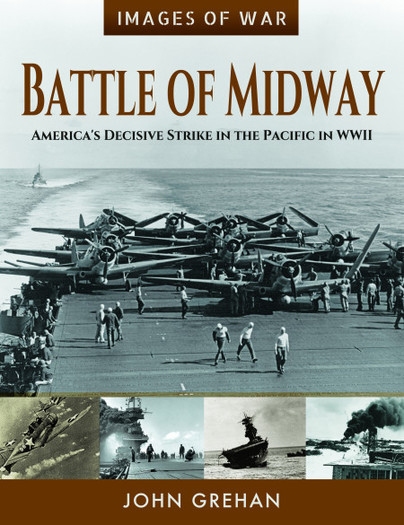| Title: | Battle of Midway - America's Decisive Strike in the Pacific in WWII |
| Writer: | Grehan, J. |
| Published: | Frontline Books |
| Published in: | 2019 |
| Pages: | 164 |
| Language: | English |
| ISBN: | 9781526758347 |
| Omschrijving: | The Images of War series typically has books based on archive photographs from the second world war, of all theatres, sometimes of battles, of units or focused on certain pieces of equipment. They all have the photographs in common, but differ greatly in topics and in style of presentation. The Battle of Midway is a more than excellent book in this series, as it has ample accompanying pages of text, and the photo captions are very exhaustive as well. Kudos to John Grehan, the author. For those readers who are maybe less familiar with the Pacific campaign in World War 2, let me expand a bit on the period covered in the book in more detail than usual, following the book’s timeline: In 1942 Japan, by the vision of Admiral Isoroku Yamamoto, set out to score a decisive victory over America’s Pacific Fleet. Yamamoto knew the Americans would remain a major threat with their powerful fleet of carriers and cruisers if they were not checked and destroyed. The Japanese plan was to first isolate Australia from the US support, and in order to do this they set out to conquer Port Moresby on Papua New Guinea. What Japan didn’t know was that their secret radio codes had been cracked and the US had decoded their messages, and hence was aware of the plan. America sent two US Navy carrier task forces to intercept the Japanese, and they were supported by a joint US/Australian cruiser force. The ensuing encounter entered history books as the Battle of the Coral Sea. Basically it was a defeat of the US-Australian task force, losing the USS Lexington carrier and having the carrier USS Yorktown seriously damaged. But it DID prevent the Japanese plans and Port Moresby remained in Australian hands. But it convinced the Japanese admiral that this was a great opportunity to destroy the remaining carriers, if only he could lure them into a trap. And that was to be the Battle of Midway. John Grehan does an excellent job in explaining all this in his Introduction chapter, including some very clear maps of the entire area, of Midway itself and of the battle chronology on June 4th, 1942. Also in the Introduction we find photos of Midway, of the major protagonists, of some of the ships involved and of the Marines defending the atol. From here on the book takes us along chronologically, starting with Chapter 1 - First Contact - and the Japanese air raid on Dutch Harbor, the US Navy’s Naval Operating Base on the Aleutian Islands in Alaska. That’s the row of little islands stretching out towards Russia in the Barentsz Sea. That was on the morning of June 3rd, 1942 at 7 am. There is not much info on this particular attack and the remainder of the chapter tells about the Catalina’s and B-17’s from Midway, used to spot the enemy ships. They did find the occupation force, and even attacked the ships, but NOT the carriers at this time. The distances involved are also mind boggling for us landlubbers. The first sighting of the Japanese ships was 700 miles from Midway. In Chapter 2 - Bombs fall on Midway - the actual attack starts, at 5:55 am on June 4th, when enemy aircraft are approaching Midway. They took off already a 4:30 that morning. While Midway tried to save its aircraft by having them take off, finally the long-awaited news came from one of the reconnaissance Catalina’s that they had spotted the Japanese carrier force. The defenders of Midway had Brewster Buffalo’s, Wildcats and a few Marauders, and of course the Catalina’s and B-17’s that were out on patrol or searching to attack the invasion fleet. The air raid on Midway ended around 6 am and the Japanese had only used half of their available aircraft. Onto Chapter 3 - Attacking the Japanese Fleet - starting at 7 am by launching the US aircraft from the carriers USS Enterprise and USS Hornet, and the Yorktown 2 hours later, having kept its aircraft in reserve. Aircraft used for the attack were the Douglas Devastator with torpedoes and the Douglas Dauntless dive bomber, supported by fighters. But before they reached the carriers, these were already attacked at 7:05 am by the small force from Midway, consisting of the 4 B-26’s and six Grumman Avengers. But there was more. There was the freshly based Marine Scout Bombing Squadron 241, equipped with the 11 SB2U-3’s, a variant of the Vought Vindicator, a dive bomber, and also with 16 Dauntless dive bombers. It were aircraft of the second (Dauntless) group that scored direct hits on the carrier Kasagi. At 8:10 am the carrier Soryo was also attacked, by the Flight 92 B-17’s from Midway, who had been en route to attack the invasion force, but had their orders changed when the carriers were detected. They scored hits from 20.000 feet on two of the carriers. At 8:30 the second group of VMSB-241, the Vindicators arrived at the scene, but could not attack the carriers due to the heavy defenses. All this time the Japanese assumed there was no major US Naval force anywhere around, because all the attacks had been carried out by land-based aircraft from Midway. That all changed when a reconnaissance aircraft from the cruiser Tone reported the sighting of 10 US ships and one carrier (this was the USS Yorktown). The Japanese now decided to change their strategy and not send a second wave of attackers to Midway, but to instead launch their attack force to destroy the USS Yorktown. At about the same time the USS Yorktown launched its Air Group to attack the four Japanese carriers. The Yorktown’s Devastators found their target ay 9:20 and were promptly annihilated by the defending Japanese Zero’s. Just a little later, at 10:00 am, the aircraft of the USS Enterprise and USS Hornet arrived and VT-6’s Devastators attacked, again without scoring any hits. The same happened with VT-3 which had 10 of its 12 aircraft shot down in the attack. When the four carriers were preparing their full complement to take off to attack the US Task Force (and without fighter cover, because most Zero’s were now on low fueling having defended the previous attacks). By this time the remaining aircraft of the USS Enterprise found the carriers, virtually unprotected, and changed the battle, and possibly the history of WW2 in the Pacific. Their bombs hit the Japanese aircraft carriers Kaga and the Akagi. The remaining Yorktown bombers found the Soryu. Chapter 4 - The Japanese hit the Yorkton. There was one Japanese carrier left operational that morning, the Hiryu, and this carrier launched 18 bombers to go and attack the US fleet. Although the Yorktown had radar and saw the attackers coming, and although it was just a small force, she got hit by several bombs. All this happened around noon. Chapter 5 - The torpedo bombers strike - brings us two and a half hours later when radar again picked up enemy aircraft. These were a group of Nakajima torpedo bombers, also originating from the Hiryu. In spite of Yorktown’s fighters and AA guns shooting down a number of the Japanese bombers, she ultimately got hit by 2 torpedoes. The crew had to abandon ship in the afternoon. Meanwhile the USS Enterprise and USS Hornet launched bombers to attack the last remaining Japanese carrier, which was hit fatally at around 17:00 hours. Chapter 6 - Operation MI cancelled. The planned invasion of Midway was still continued by the Japanese, in spite of the landing force having been spotted, until two Japanese cruisers hit each other by accident, crippling each other, and making the remaining two cruiser run away. By then Operation MI was cancelled and Midway was saved. Chapter 7 - Last shots. But all was not over yet. The USS Yorktown was still afloat and the destroyer USS Hammann was secured alongside. A salvage team was trying to pump the water out and make some urgent repairs. The USS Hornet, and later the USS Enterprise, launched their aircraft to attack the remaining Japanese fleet… And they found the two stricken cruisers that had bumped into each other the previous day. Alas, a reconnaissance aircraft had spotted the Yorktown and a Japanese submarine quickly closed in for the kill. Both the Hammann and the Yorktown were hit by torpedoes, the Hammann sank immediately, the Yorktown at 7:00 am on June the 7th. The report of that is covered in Chapter 8 - The end of USS Yorktown. And Chapter 9 finally - After the battle - has pictures of the returning warships and crews. So now you know what happened, you want to SEE it too. And that’s what this book is for, including the maps with the timeline of what happened where. I kept leafing to and fro the map pages. An excellent book with a load of interesting photos from the archives, but above all a very detailed, chronological report of the Battle of Midway, worth every one of its 164 pages! |
| Beoordeling: |      Excellent Excellent |
Information
- Article by:
- Francois Dumas
- Published on:
- 26-10-2019
- Feedback?
- Send it!




